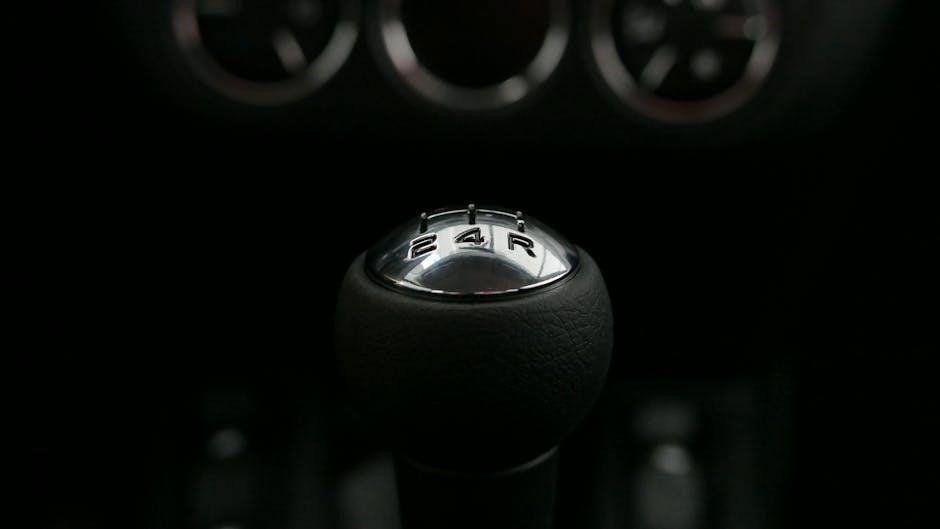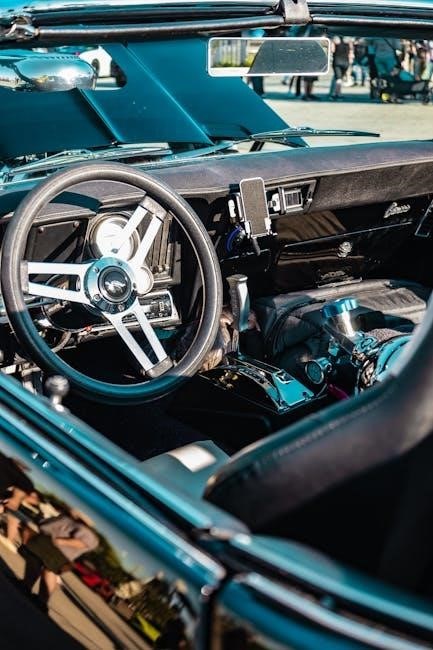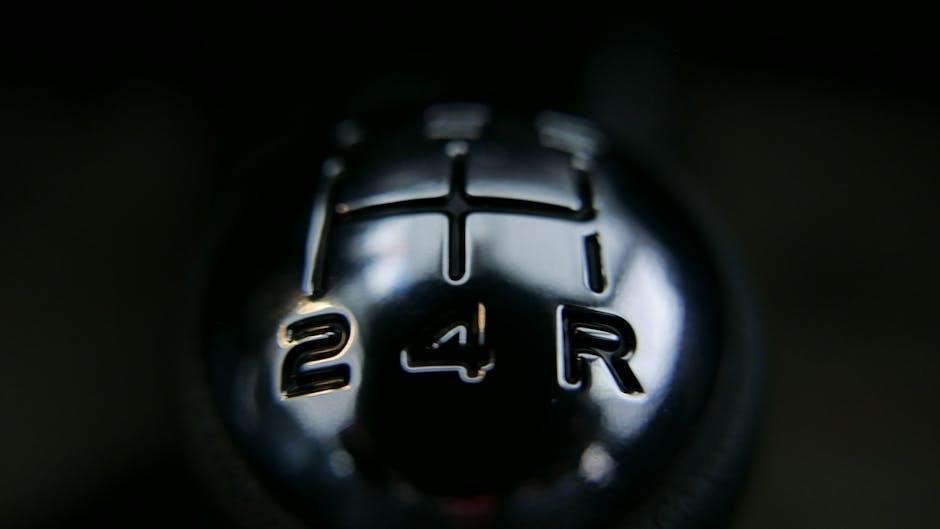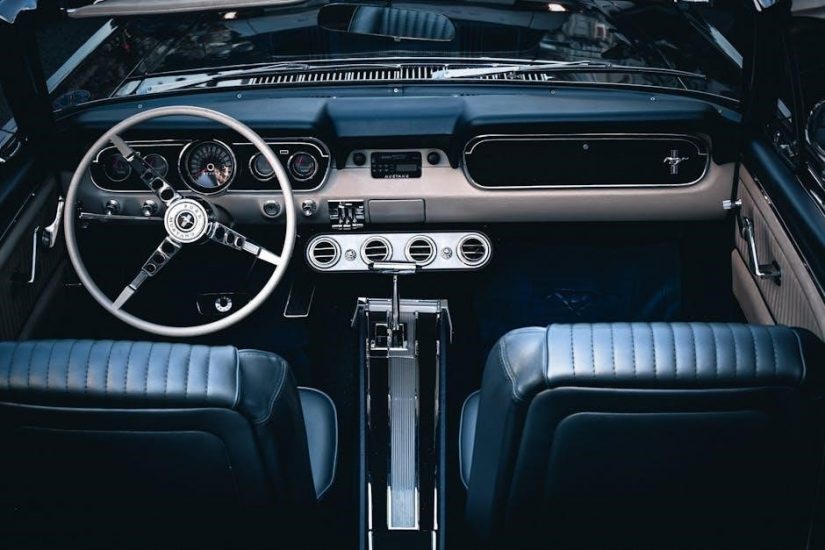The Ford Mustang’s manual transmission, notably the MT82 6-speed, offers precise control and exhilarating driving experiences, enhanced by modern features like rev-matching technology, making it a symbol of driving passion for enthusiasts.
Overview of Manual Transmission in the Mustang
The Ford Mustang’s manual transmission is a defining feature, offering drivers precise control and an engaging driving experience. The MT82 6-speed manual, used from 2011-2020, provides smooth shifting and a direct connection to the engine. It enhances performance and fuel efficiency while maintaining affordability. Key benefits include driver engagement, cost-effectiveness, and a more tactile driving experience. The manual transmission has become a hallmark of the Mustang’s identity, appealing to enthusiasts who value the thrill of hands-on driving. Its enduring popularity underscores its significance in the Mustang’s legacy.
- Precise control and driver engagement.
- Cost-effective compared to automatics.
- Enhanced performance and fuel efficiency.

Historical Significance of Manual Transmissions in the Mustang
The Ford Mustang’s manual transmission has played a pivotal role in its legacy, symbolizing freedom and driving passion. From the T-5 in the Fox Body era to the MT82 in modern models, each generation has refined the manual transmission’s performance and durability. These transmissions have become iconic, with enthusiasts cherishing the tactile connection they provide. The T-5, for instance, was the longest-running manual transmission in Mustang history, while the MT82 introduced advanced features like rev-matching technology. This evolution underscores the manual transmission’s enduring appeal in the Mustang’s identity.
- Iconic symbol of driving freedom and passion.
- Evolved from T-5 to MT82 with improved performance.
- Rev-matching technology in modern models.

History of Manual Transmissions in the Ford Mustang
The Ford Mustang’s manual transmission history spans decades, evolving from the early SROD 4-speed to the modern MT82 6-speed. Key models include the T-5, T-45, and MT82, each offering improved performance. The introduction of rev-matching technology in 2019 marked a significant advancement, enhancing driver engagement and precision.
Early Manual Transmissions (1979-1995)
The Ford Mustang’s early manual transmissions, introduced in 1979, featured the SROD 4-speed, designed for the Fox Body Mustang. Limited to 200lb-ft of torque, it was replaced by the T-5 5-speed in the late 1980s, offering improved durability. The T-5 became standard, known for its robust design and higher torque capacity. By the mid-1990s, the T-45 5-speed debuted, introducing a fully synchronized reverse gear and updated features like an electronic speedometer. These early transmissions laid the foundation for future advancements, balancing performance and reliability for the evolving Mustang lineup.
Evolution of Manual Transmissions in the 2000s
In the 2000s, Ford introduced the TR-3650 and TR-6060 transmissions, offering enhanced performance and durability. The TR-3650, used in the early 2000s, featured a stronger design and smoother shifting. The TR-6060, with its six-speed capability, became a favorite among enthusiasts, known for its precise gear engagement and higher torque capacity. These transmissions were integral to the Mustang’s reputation, providing drivers with improved control and responsiveness, while setting the stage for future advancements in manual transmission technology.
Modern Manual Transmissions (2010s-Present)
The 2010s introduced the Getrag MT82 6-speed manual transmission, which became standard for Mustangs from 2011 to 2020. Despite initial criticisms, the MT82 offered a sport-tuned experience. In the 2020s, Ford upgraded to the MT82-D4, enhancing durability and performance. For the 2024 Mustang Dark Horse, Ford introduced the TREMEC TR 3160 6-speed manual, featuring a titanium-anodized shifter and rev-matching technology. These advancements reflect Ford’s commitment to refining manual transmissions, ensuring they remain a thrilling option for driving enthusiasts.

Key Components of the Mustang Manual Transmission
The Mustang’s manual transmission features gear ratios optimized for acceleration and cruising, along with robust torque capacity. Key components include the MT82/MT82-D4 6-speed units, synchronized gears, and reverse functionality.
Gear Ratios and Torque Capacity
The Ford Mustang’s manual transmission, such as the MT82 and MT82-D4, offers optimized gear ratios for both acceleration and highway cruising. For instance, the MT82 features a first gear ratio of 3.37 and a sixth gear ratio of 0.62, providing a balance of power delivery and fuel efficiency. The torque capacity is designed to handle the Mustang’s powerful engines, with the MT82 capable of managing up to 444 lb-ft of torque. These specifications ensure smooth shifting and robust performance for drivers seeking both daily reliability and track-worthy capability.
Common Issues and Solutions
The Ford Mustang’s manual transmission, particularly the MT82, has faced criticism for issues like a weak 10-spline input shaft and synchronization problems. These issues often arise under high-stress driving conditions. Solutions include upgrading to an 11-spline input shaft for improved durability and installing aftermarket synchronizer kits for smoother shifting. Additionally, the reverse fork and speedometer sensor gear have been known to fail in older models like the T45, requiring replacement. Regular maintenance, such as fluid changes, can also help prevent premature wear and ensure long-term reliability.
Upgrade Options for Improved Performance
For enthusiasts seeking enhanced performance, upgrading the Ford Mustang’s manual transmission offers several options. The MT82 can be improved with an 11-spline input shaft for increased strength and durability. Lightweight flywheels and high-performance clutches reduce inertia and improve engagement. Short-throw shifters enhance shifting precision and responsiveness. Additionally, gear ratio adjustments and aftermarket transmission mounts can further optimize acceleration and stability. These upgrades not only address common issues but also elevate the driving experience, making the Mustang even more capable on both the street and the track.

Performance and Handling with a Manual Transmission
The Ford Mustang’s manual transmission delivers exceptional driving engagement, with precise control and responsiveness. Rev-matching technology enhances downshifts, while the direct connection to the engine elevates handling precision and fun.
Rev-Matching Technology in Modern Mustangs
Rev-matching technology in modern Mustangs enhances driving precision by automatically adjusting engine RPMs during downshifts, ensuring smoother transitions and improved control. This feature, standard in the 2019 Mustang GT with a manual transmission, allows drivers to focus on steering and braking, particularly during aggressive cornering. By synchronizing engine speed with wheel speed, it reduces wear on the drivetrain and delivers a more refined, track-ready experience, making it a standout innovation for performance enthusiasts.
Comparison of Manual vs. Automatic Transmissions
The Ford Mustang offers both manual and automatic transmissions, catering to different driving preferences. Manual transmissions provide direct control, cost less, and are often considered more engaging, ideal for enthusiasts. Automatics, like the 10-speed SelectShift, offer convenience, smoother shifting, and better suitability for daily driving. While manuals deliver a more immersive experience, automatics prioritize ease and adaptability, making them a practical choice for urban and highway commutes. Both options ensure exceptional performance, with the choice depending on personal preference and driving habits.
Driver Engagement and Control
Manual transmissions in the Ford Mustang amplify driver engagement by offering precise control over gear shifts, allowing for a more immersive and connected driving experience. The ability to manually select gears creates a deeper bond between the driver and the vehicle, enhancing the thrill of the drive. Features like rev-matching technology further refine this connection, enabling smooth downshifts and maintaining optimal control during spirited driving. This hands-on approach makes the Mustang a standout choice for enthusiasts who value the art of driving and the satisfaction of mastering it.

Transmission Codes and Specifications
The Ford Mustang’s manual transmission is identified by codes like MT82 and MT82-D4, with the MT82 being the standard 6-speed manual for 2011-2020 models, offering a torque capacity of up to 405 lb-ft. The MT82-D4 variant, used in the 2019-2021 Mustang GT 5.0, features enhanced gear ratios and torque handling capabilities, ensuring optimal performance for enthusiast drivers.
MT82 and MT82-D4 Transmission Codes
The MT82 and MT82-D4 are key transmission codes for the Ford Mustang’s manual gearbox. The MT82 is the standard 6-speed manual transmission used from 2011 to 2020, known for its durability and smooth shifting. The MT82-D4, introduced in 2019 for the Mustang GT 5.0, features an upgraded design with improved torque capacity and gear ratios, enhancing performance for high-power engines. Both codes represent Ford’s commitment to delivering precise control and power handling, catering to both daily drivers and enthusiasts seeking a thrilling driving experience.
Understanding Gear Ratios for Different Models
Gear ratios in the Ford Mustang’s manual transmission vary by model and engine configuration, optimizing performance and drivability. For instance, the T45 transmission in 1996-2004 Mustangs features ratios of 3.37:1 (1st), 1.99:1 (2nd), 1.33:1 (3rd), 1.00:1 (4th), and 0.68:1 (5th). The MT82 in 2019-2021 models offers slightly taller ratios, such as 3.91:1 (1st) and 0.62:1 (6th), providing smoother acceleration and better highway cruising. These tailored gear ratios enhance the Mustang’s balance of power delivery and fuel efficiency, catering to both performance-driven and everyday driving scenarios.
Torque Capacity and Power Handling
The Ford Mustang’s manual transmissions are designed to handle varying levels of torque, depending on the model and engine. The MT82 transmission, for example, has a torque capacity of approximately 405 lb-ft, making it suitable for the 5.0L V8 engine. Earlier models, such as the T45, were rated for lower torque outputs, around 300 lb-ft. However, certain transmissions, like the MT82-D4, are engineered to handle higher power applications, though they may still face limitations when exceeding 500 lb-ft. This balance of power and durability ensures optimal performance for both everyday driving and enthusiast use.

Model-Specific Manual Transmission Details
The 2023-2024 Mustang GT features the MT82-D4 6-speed manual, while EcoBoost models rely on automatics, and special editions like the Dark Horse offer unique manual transmission features.
2023-2024 Mustang GT Manual Transmission
The 2023-2024 Ford Mustang GT features the Getrag MT82-D4 6-speed manual transmission, pairing seamlessly with its 5.0L V8 engine. This setup offers precise control and a thrilling driving experience, enhanced by rev-matching technology for smoother downshifts. The MT82-D4 is designed to handle increased torque, providing reliability and responsiveness. Drivers can enjoy a direct connection to the engine, making every shift a deliberate and engaging interaction. This combination underscores the Mustang GT’s commitment to performance and driver involvement.
EcoBoost Models and Manual Transmission Availability
The 2023-2024 Ford Mustang EcoBoost models no longer offer a manual transmission option, as the 10-speed automatic has become the sole choice for these trims. This decision aligns with market trends, as most EcoBoost buyers historically opted for the automatic. While the EcoBoost lacks a three-pedal setup, other Mustang models, such as the GT, continue to provide a manual transmission for driving enthusiasts who prefer a more hands-on experience behind the wheel.
Special Editions and Their Transmission Features
Special-edition Mustangs often feature unique manual transmission configurations. The 2025 Mustang Dark Horse, for instance, boasts an exclusive TREMEC TR 3160 6-speed manual transmission with a titanium-anodized blue knob. This setup offers precise shifting and rev-matching technology, enhancing both performance and driver engagement. Other limited editions, like the Bullitt, have historically included performance-tuned manual transmissions, emphasizing the connection between driver and machine. These exclusive models cater to enthusiasts seeking a more distinct and exhilarating driving experience.

Maintenance and Care for the Manual Transmission
Regular fluid checks and proper shifting techniques are crucial for maintaining the Mustang’s manual transmission. Inspect for leaks and ensure timely servicing to optimize performance and longevity.
Tips for Extending Transmission Life
Regular maintenance is key to prolonging the life of your Mustang’s manual transmission. Check transmission fluid levels frequently and replace it as recommended to prevent wear. Avoid aggressive driving habits, such as rapid acceleration or harsh shifting, which can strain components. Always warm up the engine before driving and use the clutch gently to reduce stress on the system. Proper shifting techniques and avoiding riding the clutch can significantly extend the transmission’s lifespan. Schedule regular inspections to catch potential issues early and ensure smooth performance.

Common Maintenance Practices
Regular maintenance is essential for the longevity of your Mustang’s manual transmission. Check transmission fluid levels and replace it every 30,000 to 60,000 miles to ensure proper lubrication. Inspect the transmission pan gasket for leaks and replace it if necessary. Clean or replace the transmission filter during fluid changes to maintain optimal performance. Additionally, inspect synchronizer rings and bearings for wear and tear, and replace them as needed. Proper care ensures smooth shifting and prevents premature wear on critical components.
Repair Options and Cost Considerations
Repairing a manual transmission in a Ford Mustang can vary in cost depending on the issue. Replacing the MT82 transmission entirely can range from $2,000 to $4,000 for a used unit, while a new transmission may cost up to $6,000. Common repairs include replacing the input shaft or synchronizer rings, which can cost between $500 to $1,500. For severe damage, a factory-refurbished transmission may be a reliable option, priced around $4,500. Always consult a certified mechanic for accurate diagnostics and quotes.

Future of Manual Transmissions in the Mustang
The future of manual transmissions in the Mustang remains bright, with innovations like rev-matching technology and enthusiast demand ensuring their relevance alongside electric vehicle advancements.
Current Trends and Innovations
Modern Ford Mustang manual transmissions, like the TREMEC TR 3160 in the 2024 Dark Horse, feature exclusive innovations such as titanium-anodized shift knobs and enhanced rev-matching technology. The 2024 Mustang GT also offers a refined 6-speed manual with standard rev-matching, improving both performance and driver engagement. These advancements highlight Ford’s commitment to blending tradition with cutting-edge engineering, ensuring manual transmissions remain a vibrant part of the Mustang’s legacy despite the rise of automatics and electric vehicles.
Impact of Electric Vehicles on Manual Transmissions
The rise of electric vehicles (EVs) has sparked questions about the future of manual transmissions in the Ford Mustang; EVs typically feature single-speed or dual-speed setups, eliminating the need for manual shifting. As Ford transitions toward electrification, the focus on manual transmissions may diminish. However, the Mustang’s iconic status suggests that manual options will likely remain for select models, especially performance-oriented variants like the GT. Enthusiasts’ demand for tactile driving experiences ensures manuals won’t vanish entirely, even as EVs gain prominence.
Enthusiast Community and Manual Transmission Demand
The Ford Mustang’s manual transmission remains a cornerstone of its appeal, driven by a passionate enthusiast community. Drivers who value tactile control and the emotional connection of shifting gears continue to demand manual options. This dedication has ensured the Mustang’s manual transmission remains relevant, even as automatic and EV options grow. Ford has responded by retaining the MT82 and newer TREMEC transmissions in select models, catering to purists who prioritize the driving experience. The enthusiast community’s influence ensures the manual transmission’s legacy endures, even in an evolving automotive landscape.
